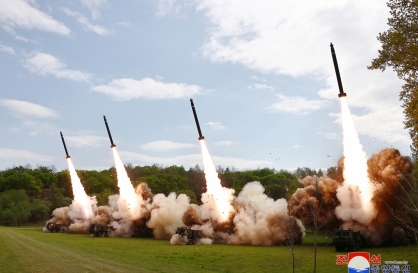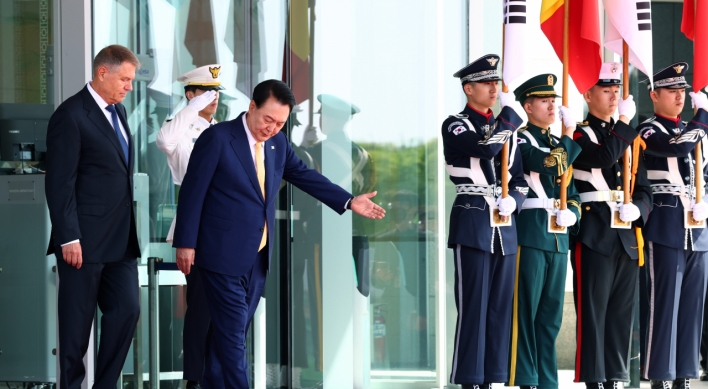SINGAPORE (AP) ― Asia batted away the global recession sparked by the 2008 financial crisis. Fending off the latest wave of market turmoil may prove tougher.
World stocks were pummeled this week by the first-ever downgrade of the U.S. credit rating and evidence of stalling recoveries in the U.S. and Europe that could weaken demand for Asia’s exports of cars, gadgets, clothing and other goods.
World stocks were pummeled this week by the first-ever downgrade of the U.S. credit rating and evidence of stalling recoveries in the U.S. and Europe that could weaken demand for Asia’s exports of cars, gadgets, clothing and other goods.

Normally that would have Asian governments turning to interest rate cuts and extra spending but their options are constrained by inflation that has remained stubbornly high despite efforts to tame it.
The dilemma: Give economies too much of a boost and the high inflation that is undermining gains in living standards will become even more troublesome. Press ahead with the yearlong campaign to bring inflation down and risk a sharp decline in economic growth just as the U.S., the world’s biggest economy, teeters on the edge of another recession.
Singapore, heavily reliant on the spending power of U.S. consumers, was Wednesday among the first to acknowledge the increased risks, lowering its economic growth forecast for this year.
“It’s a tough balance, but inflation in Asia is going to keep the pressure on policymakers,” said Neeraj Seth, an executive at BlackRock, which manages $3.7 trillion of assets.
China, Asia’s largest economy, may have to sacrifice some of the breakneck growth it’s enjoyed over the last decade to get inflation under control. Consumer prices jumped 6.5 percent in July, a three-year high, while the economy expanded a roaring 9.5 percent in the second quarter.
China has raised interest rates five times since October and curbed lending and investment, but the government admits it probably won’t be enough to slow inflation to its 2011 target of 4 percent.
“The problem is still that growth is too fast and inflation is too high and going up,” said David Carbon, head of Asia research at DBS, Southeast Asia’s largest bank.
Quickening inflation threatens to swell the ranks of people in countries such as China, India and Vietnam already living below the poverty line. Vietnam has the region’s highest annual inflation rate at 21 percent while India’s is 8.6 percent. Rapid rises in prices, especially for food, are a threat to social stability, which in the past decade has been underpinned by the rising living standards that Asia’s robust economic growth has delivered.
The Asian Development Bank estimates that a 10 percent increase in food prices drags another 64 million people below the $1.25 a day poverty line. A 20 percent increase in prices pushes up the number in poverty by 129 million.
“Everything is getting much more expensive, but I’m not getting an increase in my salary. I have to dig into my savings,” said high school teacher Nguyen Bich Lien, 53, as she bought vegetables at a market in Vietnam’s capital Hanoi.
“It costs me 400,000 dong to 500,000 dong ($19 to $24) for one day of shopping, I feel like my money was stolen.”
“When my savings are all spent, then I will have to eat less meat and more vegetables,” she said, adding she earns 8 million dong a month as the breadwinner of her family because her husband is too sick to work.
“I can imagine how much harder low-income workers and farmers have to struggle to make ends meet,” she said.
Still, several factors should help buffer Asia from turmoil in the U.S. and Europe. Asia’s dependence on consumers in the West has gradually fallen as trade within the region grew and as expanded middle classes became a bigger engine of growth.
Most Asian countries didn’t slide into recession in the aftermath of the 2008 global financial crisis. Those that did, such as Singapore and Hong Kong, rebounded strongly partly because governments had previously banked large surpluses and were able to boost spending.
Asian countries, excluding Japan and India, still have low debt compared to the U.S. and Europe and could quickly ramp up borrowing to spend more if worst-case scenarios play out in developed nations.
“Policymakers in Asia have plenty of scope to introduce more monetary and fiscal stimulus to support their economies,” said Sukhy Ubhi, an analyst with Capital Economics.
Expectations of slowing global growth have also brought down commodity prices. Crude oil has dropped 30 percent since May and should help lower food and energy costs.
Yet there are some caveats. China rolled out a massive stimulus program in 2009 to boost lending and bolster growth. Not all the investments were sound and a mountain of bad loans could limit the government’s options should more economic stimulus be necessary.


![[AtoZ into Korean mind] Humor in Korea: Navigating the line between what's funny and not](http://res.heraldm.com/phpwas/restmb_idxmake.php?idx=644&simg=/content/image/2024/04/22/20240422050642_0.jpg&u=)



![[Herald Interview] Why Toss invited hackers to penetrate its system](http://res.heraldm.com/phpwas/restmb_idxmake.php?idx=644&simg=/content/image/2024/04/22/20240422050569_0.jpg&u=20240422150649)

![[Graphic News] 77% of young Koreans still financially dependent](http://res.heraldm.com/phpwas/restmb_idxmake.php?idx=644&simg=/content/image/2024/04/22/20240422050762_0.gif&u=)





![[Exclusive] Korean military to ban iPhones over security issues](http://res.heraldm.com/phpwas/restmb_idxmake.php?idx=652&simg=/content/image/2024/04/23/20240423050599_0.jpg&u=)



